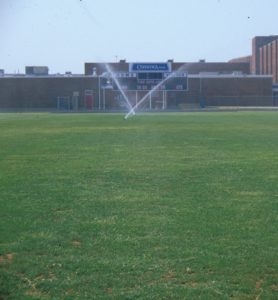Developed by Becky Grubbs, PhD and Ben Wherley, PhD AggieTurf to help you manage your turf a water-wise checklist for the hottest and driest months of the year. Click this link for a downloadable version
Task |
Reason |
Additional Resources |
Mowing |
||
| Mow at the upper end of the appropriate mowing height range for your species of grass | Taller grass = Deeper Roots. Deeper roots can improve overall infiltration and access to water deeper in the soil. | For more information on appropriate mowing heights for your species, visit the AggieTurf Website. https://aggieturf.tamu.edu/ |
| Follow the 1/3 Rule. Mow frequently enough to never remove more than 1/3 of the total grass mowing height at one time. | Scalped grass is stressed grass. Stressed grass will be less tolerant to heat and drought, and more vulnerable to other pests or fungal pathogens. |  |
Irrigation |
||
| Water deeply and infrequently. Try to water to a depth of approximately 6″ each time you water. | Watering this way encourages deeper, denser root growth. Again, this can improve infiltration and access to water deeper in the soil. |
|
Wait to water until visual wilt is occurring, and do so late at night or early in the morning. |
Watering late at night or early in the morning will reduce evaporative losses, improve water-use efficiency, and reduce length of overall leaf wetness, which reduces disease potential. |  |
|
Use the Cycle Soak Method. |
Because sprinkler precipitation rates usually exceed soil infiltration rates, cycle soaking improves soil water infiltration and reduces runoff by “pulsing” water onto the lawn in small amounts over several hours. | Check out this video from Dr. Richard White on the Cycle Soak Method. https://www.youtube.com/watch?v=Vmr9Y bHTjL0&t=27s |
|
Monitor your irrigation equipment judiciously. |
Broken or malfunctioning irrigation equipment can both waste water and create localized dry spots across the lawn. Replace broken heads, and consider a professional irrigation audit by a licensed irrigator. | Want to check your irrigation efficiency on your own? Check out AgriLife Water University’s video on the Catch Can Method. https://www.youtube.com/watch?v=1nIwZ |
| Take advantage of rainwater. | Rainwater catchment can help you take advantage of natural precipitation and supplement irrigation water. | A number of AgriLife programs offer courses on rainwater catchment. Check out these programs, or contact your County Extension Agent for local resources:
Healthy Lawns, Healthy Waters https://hlhw.tamu.edu/ Water University https://wateruniversity.tamu.edu/ |
Cultivation |
||
|
Till new areas before replacing or installing new sod. |
Prepare areas for new sod by tilling the area to a depth of 6” to 12″, when possible. Good site preparation is critical to improving water infiltration and laying the literal groundwork for a healthy stand of turfgrass. | |
|
Look ahead. |
In the spring and fall, consider core aeration and thatch removal to improve overall water infiltration for active growing months. | Not sure what to do here? Contact your local County Extension Agent for additional input. |
Want more? Check out the AggieTurf website: https://aggieturf.tamu.edu/
Follow Dr. Grubbs @TXTurfGal (Twitter)
Follow @AggieTurf (Twitter, Facebook, Instagram)

 .
.